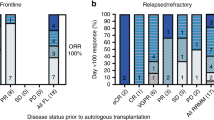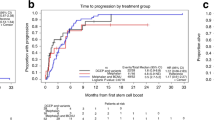Abstract
In spite of high-dose chemotherapy followed by autologous hematopoietic SCT multiple myeloma (MM) eventually recurs, highlighting the need for more effective treatment approaches. Patients received topotecan 3.5 mg/m2 intravenously on days –6 to –2, melphalan 70 mg/m2 intravenously on days –3 and –2 and CY 1 g/m2 intravenously on days –6, –5 and –4. Overall response rate (ORR) consisting of complete response and partial response (CR+PR, PFS, OS and toxicity are reported. Between August 2002 to March 2004, 60 patients (34 men and 26 women) with a median age of 61 years (range 45–72) were enrolled. Forty-one patients were treated for consolidation of first remission, while 19 patients had relapsed/refractory disease. ORR was 85% (CR 12%, very good PR 43% and PR 30%). Median time to neutrophil (ANC>0.5 × 109/L) and plt engraftment (>20 × 109/L) was 10 (range 7–12 days) and 9 days (range 6–79 days), respectively. A majority of the common adverse events were grade 1–3 mucositis/stomatitis (65%), grade 1 or 2 nausea (59%) and grade 1 or 2 diarrhea (41%). Median PFS was 18.5 months and median OS has yet not been reached. In conclusion, topotecan, melphalan and CY is a safe and active conditioning regimen for auto hematopoietic SCT in MM. The ORR and PFS were comparable to high-dose melphalan.
This is a preview of subscription content, access via your institution
Access options
Subscribe to this journal
Receive 12 print issues and online access
$259.00 per year
only $21.58 per issue
Buy this article
- Purchase on Springer Link
- Instant access to full article PDF
Prices may be subject to local taxes which are calculated during checkout

Similar content being viewed by others
References
Horner MJ, Ries LAG, Krapcho M, Neyman N, Aminou R, Howlader N et al. SEER cancer statistics review, 1975–2006. National Cancer Institute: Bethesda, 2008. Available from http://seer.cancer.gov/csr/1975_2006/ based on November 2008 SEER data submission, posted to the SEER website, 2009.
Attal M, Harousseau JL, Stoppa AM, Sotto KL, Fuzibet JG, Rossi JF et al. A prospective, randomized trial of autologous bone marrow transplantation and chemotherapy in multiple myeloma. Intergroupe Francais du Myelome. N Engl J Med 1996; 335: 91–97.
Child JA, Morgan GJ, Davies FE, Owen RG, Bell SE, Hawkins K et al. High-dose chemotherapy with hematopoietic stem-cell rescue for multiple myeloma. N Engl J Med 2003; 348: 1875–1883.
Barlogie B, Kyle RA, Anderson KC, Greipp PR, Lazarus HM, Hurd DD et al. Standard chemotherapy compared with high-dose chemoradiotherapy for multiple myeloma: final results of phase III US Intergroup Trial S9321. J Clin Oncol 2006; 24: 929–936.
Blade J, Rosinol L, Sureda A, Ribera JM, Diaz-Mediavilla J, Garcia-Larana J et al. High-dose therapy intensification compared with continued standard chemotherapy in multiple myeloma patients responding to the initial chemotherapy: long-term results from a prospective randomized trial from the Spanish cooperative group PETHEMA. Blood 2005; 106: 3755–3759.
Conte LG, Figueroa MG, Lois VV, Cabrera CME, Leon RA, Garcia LH et al. Prognostic value of the new international staging system in multiple myeloma. Comparison with Durie-Salmon staging system. Rev Med Chil 2008; 136: 7–12.
Qazilbash MH, Saliba RM, Ahmed B, Parikh G, Mendoza F, Ashraf N et al. Deletion of the short arm of chromosome 1 (del 1p) is a strong predictor of poor outcome in myeloma patients undergoing an autotransplant. Biol Blood Marrow Transplant 2007; 13: 1066–1072.
Qazilbash MH, Saliba RM, Aleman A, Lei X, Weber D, Carrasco A et al. Risk factors for relapse after complete remission with high-dose therapy for multiple myeloma. Leuk Lymphoma 2006; 47: 1360–1364.
Alexanian R, Weber D, Giralt S, Dimopoulos M, Delasalle K, Smith T et al. Impact of complete remission with intensive therapy in patients with responsive multiple myeloma. Bone Marrow Transplant 2001; 27: 1037–1043.
Wang M, Delasalle K, Feng L, Thomas S, Giralt S, Qazilbash M et al. CR represents an early index of potential long survival in multiple myeloma. Bone Marrow Transplant 2010; 45: 498–504.
Moreau P, Facon T, Attal M, Hulin C, Michallet M, Maloisel F et al. Comparison of 200 mg/m(2) melphalan and 8 Gy total body irradiation plus 140 mg/m(2) melphalan as conditioning regimens for peripheral blood stem cell transplantation in patients with newly diagnosed multiple myeloma: final analysis of the Intergroupe Francophone du Myelome 9502 randomized trial. Blood 2002; 99: 731–735.
Fenk R, Schneider P, Kropff M, Huenerlituerkoglu AN, Steidl U, Aul C et al. High-dose idarubicin, cyclophosphamide and melphalan as conditioning for autologous stem cell transplantation increases treatment-related mortality in patients with multiple myeloma: results of a randomised study. Br J Haematol 2005; 130: 588–594.
Shimoni A, Smith TL, Aleman A, Weber D, Dimopoulos M, Anderlini P et al. Thiotepa, busulfan, cyclophosphamide (TBC) and autologous hematopoietic transplantation: an intensive regimen for the treatment of multiple myeloma. Bone Marrow Transplant 2001; 27: 821–828.
Lahuerta JJ, Grande C, Martinez-Lopez J, De La Serna J, Toscano R, Ortiz MC et al. Tandem transplants with different high-dose regimens improve the complete remission rates in multiple myeloma. Results of a Grupo Espanol de Sindromes Linfoproliferativos/Trasplante Autologo de Medula Osea phase II trial. Br J Haematol 2003; 120: 296–303.
Spencer A, Prince HM, Roberts AW, Prosser IW, Bradstock KF, Coyle L et al. Consolidation therapy with low-dose thalidomide and prednisolone prolongs the survival of multiple myeloma patients undergoing a single autologous stem-cell transplantation procedure. J Clin Oncol 2009; 27: 1788–1793.
Kraut EH, Crowley JJ, Wade JL, Laufman LR, Alsina M, Taylor SA et al. Evaluation of topotecan in resistant and relapsing multiple myeloma: a Southwest Oncology Group study. J Clin Oncol 1998; 16: 589–592.
Kraut EH, Young D, Farag S, James AG, Solove RJ . Phase II study of topotecan and cyclophosphamide in patients with relapsed and refractory multiple myeloma. Leuk Res 2005; 29: 1233–1234.
Fitoussi O, Perreau V, Boiron JM, Bouzigon E, Cony-Makhoul P, Pigneux A et al. A comparison of toxicity following two different doses of cyclophosphamide for mobilization of peripheral blood progenitor cells in 116 multiple myeloma patients. Bone Marrow Transplant 2001; 27: 837–842.
Durie BG, Harousseau JL, Miguel JS, Bladé J, Barlogie B, Anderson K et al. International uniform response criteria for multiple myeloma. Leukemia 2006; 20: 1467–1473.
Durie BG, Salmon SE . A clinical staging system for multiple myeloma. Correlation of measured myeloma cell mass with presenting clinical features, response to treatment, and survival. Cancer 1975; 36: 842–854.
Anagnostopoulos A, Aleman A, Ayers G, Donato M, Champlin R, Weber D et al. Comparison of high-dose melphalan with a more intensive regimen of thiotepa, busulfan, and cyclophosphamide for patients with multiple myeloma. Cancer 2004; 100: 2607–2612.
Benson Jr DM, Elder PJ, Lin TS, Blum W, Penza S, Avalos B et al. High-dose melphalan versus busulfan, cyclophosphamide, and etoposide as preparative regimens for autologous stem cell transplantation in patients with multiple myeloma. Leuk Res 2007; 31: 1069–1075.
Author information
Authors and Affiliations
Corresponding author
Ethics declarations
Competing interests
The authors declare no conflict of interest.
Rights and permissions
About this article
Cite this article
Kazmi, S., Saliba, R., Donato, M. et al. Phase II trial of high-dose topotecan, melphalan and CY with autologous stem cell support for multiple myeloma. Bone Marrow Transplant 46, 510–515 (2011). https://doi.org/10.1038/bmt.2010.160
Received:
Revised:
Accepted:
Published:
Issue Date:
DOI: https://doi.org/10.1038/bmt.2010.160
Keywords
This article is cited by
-
High-dose bendamustine and melphalan conditioning for autologous stem cell transplantation for patients with multiple myeloma
Bone Marrow Transplantation (2019)
-
Pazopanib maintenance therapy after tandem high-dose chemotherapy for disseminated Ewing sarcoma
International Cancer Conference Journal (2019)
-
In vitro assay for measuring real time topotecan release from liposomes: release kinetics and cellular internalization
Drug Delivery and Translational Research (2017)
-
A phase II study of V-BEAM as conditioning regimen before second auto-SCT for multiple myeloma
Bone Marrow Transplantation (2014)
-
A phase I/II study of CY and topotecan in patients with high-risk malignancies undergoing autologous hematopoietic cell transplantation: the St Jude long-term follow-up
Bone Marrow Transplantation (2012)



